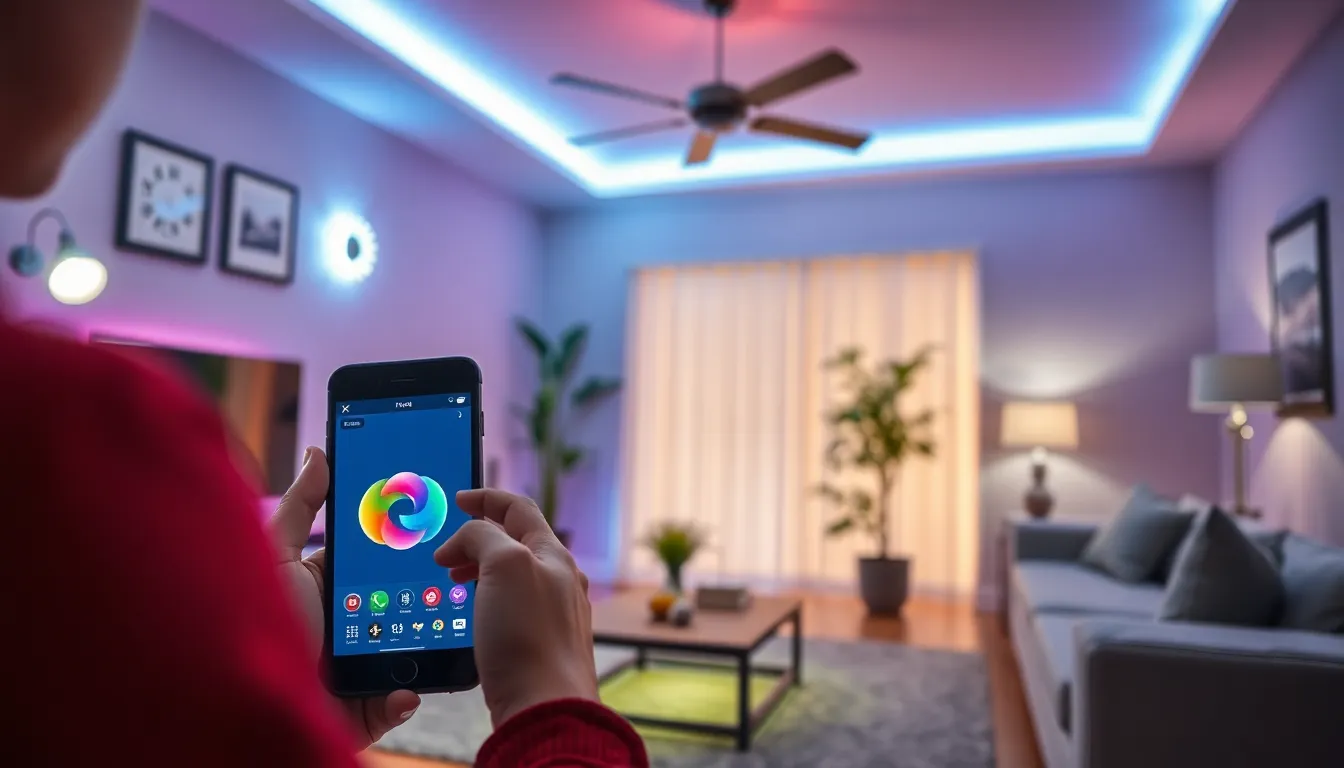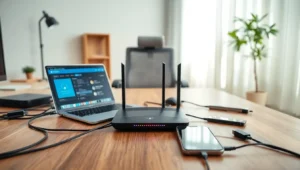Imagine walking into a room and having the lights greet you like an old friend. That’s the magic of smart lighting apps. These little powerhouses let you control your home’s ambiance with just a tap on your phone. No more fumbling for switches in the dark or arguing with your partner over the perfect lighting for movie night.
With smart lighting, you can set the mood for any occasion, whether it’s a romantic dinner or a spontaneous dance party in your living room. Plus, they can even help save energy—so you can feel good about your eco-friendly choices while still enjoying a disco ball effect. Dive into the world of smart lighting apps and discover how they can transform your home into a dazzling, energy-efficient haven.
Table of Contents
ToggleOverview of Smart Lighting Apps
Smart lighting apps provide users with the ability to control their home lighting through mobile devices. These applications enhance comfort, style, and sustainability in various living spaces.
Definition and Purpose
Smart lighting apps allow users to manage lighting systems remotely. Users can adjust brightness, color, and scheduling according to personal preferences. These apps connect with smart bulbs or fixtures through Wi-Fi or Bluetooth. The main purpose focuses on convenience, energy efficiency, and customization. Users can create specific lighting scenes that match moods or activities, whether relaxing or entertaining. Energy consumption reduction also plays a crucial role, as automation enables lights to turn off when not in use.
Popular Smart Lighting Apps
Several smart lighting apps dominate the market. Philips Hue stands out for its extensive compatibility with smart home ecosystems. LIFX offers vibrant colors without requiring a hub, making it user-friendly. Google Home integrates seamlessly with various smart devices, allowing centralized management. Wyze provides an affordable option while maintaining quality control features. Lastly, SmartThings serves as a versatile application that supports numerous smart devices beyond lighting. Each app offers unique features, adapting to user needs and preferences, and transforming the way individuals experience lighting at home.
Key Features of Smart Lighting Apps

Smart lighting apps come equipped with a variety of features designed to enhance user experience. They offer flexible controls, allowing users to customize their lighting settings based on individual preferences.
Remote Control and Automation
Remote control functionality enables users to manage their lighting from anywhere. Adjusting brightness or color while away from home becomes simple with a smartphone. Scheduling lights to turn on or off at specific times can enhance security and save energy. Automation features allow for customizable routines, such as gradually dimming lights at night. These capabilities contribute to a seamless user experience, ensuring convenience in daily life.
Integration with Smart Home Systems
Integration with smart home systems enhances the functionality of smart lighting apps. Compatibility with devices like Amazon Alexa and Google Assistant enables voice control for hands-free operation. Users can sync lighting with environmental sensors, allowing automatic adjustments based on factors like sunlight or room occupancy. The ability to create scenarios that adjust multiple devices simultaneously adds to the efficiency. Such integration provides a cohesive smart home environment, streamlining how users interact with their living spaces.
Benefits of Using Smart Lighting Apps
Smart lighting apps provide significant advantages for enhancing home environments. Users benefit from greater control over their lighting experiences.
Energy Efficiency
Energy efficiency stands out as a primary benefit of smart lighting apps. Users can monitor energy consumption and adjust settings to reduce electricity bills. For instance, scheduling lights to turn off during daylight saves energy. Many apps also provide usage statistics, helping users make informed decisions about their lighting habits. By using LED smart bulbs, users decrease energy usage compared to traditional bulbs. Remote accessibility allows users to turn off lights they may have forgotten, further promoting efficiency. Overall, smart lighting apps contribute to a more sustainable lifestyle.
Enhanced User Experience
Enhanced user experience is another key advantage of smart lighting apps. Customization options enable users to create specific lighting scenes for various occasions. For example, users can select warm tones for relaxation or brighter settings for productivity. Voice control functionality integrates with smart home systems, simplifying management. Automatic scheduling aligns lighting with daily routines, adding convenience. Additionally, many apps feature intuitive interfaces, making navigation easy. Overall, smart lighting apps enrich the daily experience by providing flexibility and personalization.
Considerations When Choosing Smart Lighting Apps
Selecting the right smart lighting app requires careful consideration of various factors. Ensuring compatibility with existing lighting systems and evaluating user interface plays a critical role in achieving an optimal experience.
Compatibility with Lighting Systems
Compatibility stands as a fundamental aspect when choosing smart lighting apps. Users must verify that the app works seamlessly with their selected light bulbs or fixtures. Consider both Wi-Fi and Bluetooth connectivity options, as different smart systems utilize various protocols. Check if the app supports multiple brands, allowing for a comprehensive smart home ecosystem. Whether integrating with Philips Hue, LIFX, or other brands, ensuring compatibility enhances functionality and provides access to a broader range of features. Overall, this compatibility influences users’ capacity to utilize smart lighting to its fullest potential.
User Interface and Experience
User interface significantly affects the quality of interactions with smart lighting apps. An intuitive design enables users to navigate effortlessly, making the setup process smoother. Prioritize apps that provide user-friendly controls for adjusting brightness and color settings. Clear layouts and easily accessible features enhance the overall experience, making it simple to customize lighting scenes. Look for apps that offer tutorials or help sections, guiding users through functionalities. In addition, positive experiences stem from responsiveness and quick loading times, which contribute to effective control of lighting. A well-designed interface enhances convenience and encourages consistent use.
Smart lighting apps offer a transformative approach to home illumination. By providing users with control over brightness and color from their devices they make it easy to create the perfect atmosphere for any occasion. These apps not only enhance convenience but also promote energy efficiency allowing for significant savings on electricity bills.
With features like remote management and integration with smart home systems users can enjoy a seamless experience that adds both comfort and security to their living spaces. As technology continues to advance exploring the right smart lighting app can lead to a more vibrant and eco-friendly home environment. Embracing these innovations can truly elevate everyday living.





